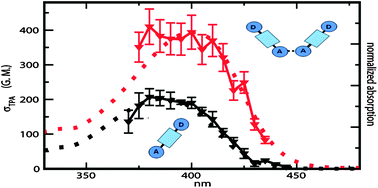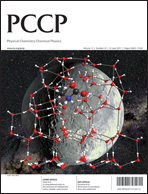The possibility to exploit a bottom-up approach to design and synthesize multichromophoric structures from a single molecular unit is strategic for the targeted synthesis of molecular compounds with well defined linear and nonlinear absorption properties. In this view, it is important to be able to predict the properties of multichromophoric units, based on the knowledge of the properties of the individual chromophores and their mutual arrangement. To this end, we present a combined experimental and theoretical study on 4-(para-di-n-butylaminostyryl)-pyridine, a push–pull molecule, and its dimer, 4,4′-bis(para-di-n-butylaminostyryl)-2,2′-bipyridine, formed by connecting the two pyridine groups into a bipyridine structure. One photon absorption and fluorescence spectra are measured in solvents of different polarity, and two-photon absorption spectra are recorded in dichloromethane. Experimental results are compared with results of TDDFT (Time-Dependent Density Functional Theory) and CIS (Configuration Interaction with Single excitation) methods implemented in the Gaussian03 program suite. An essential-state analysis of optical spectra is used to rationalize the observed behavior.

You have access to this article
 Please wait while we load your content...
Something went wrong. Try again?
Please wait while we load your content...
Something went wrong. Try again?


 Please wait while we load your content...
Please wait while we load your content...